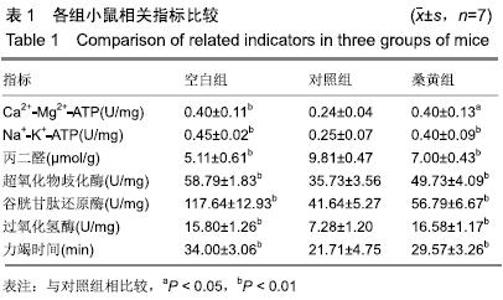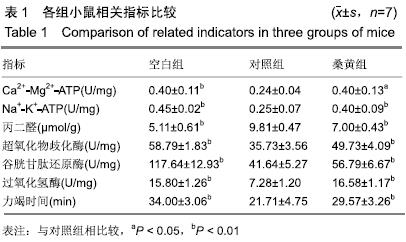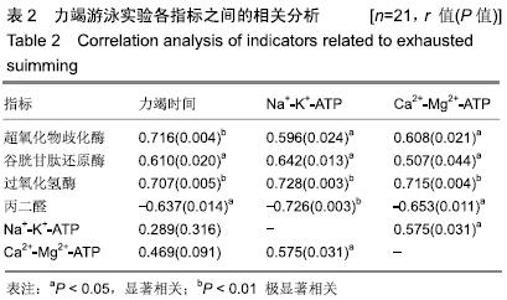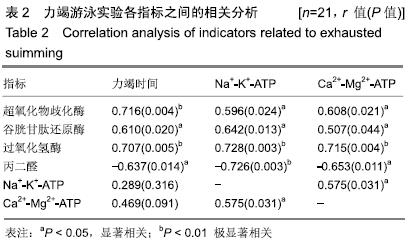[1] SHIGENAGA MK, HAGEN TM, AMES BN. Oxidative damage and mitochondrial decay in aging. Proc Natl Acad Sci U S A. 1994; 91(23):10771-10778.
[2] BERNARD S, LEBLANC P, WHITTOM F, et al. Peripheral muscle weakness in patients with chronic obstructive pulmonary disease. Am J Respir Crit Care Med. 1998;158(2): 629-634.
[3] SERRES I, GAUTIER V, VARRAY A, et al. Impaired skeletal muscle endurance related to physical inactivity and altered lung function in COPD patients. Chest. 1998;113(4):900-905.
[4] ZHUANG J, ZHANG L, DAI S, et al. Comparison of multi-tissue aging between human and mouse. Sci Rep. 2019; 9(1):6220.
[5] LIN JL, THOMAS PS. Current perspectives of oxidative stress and its measurement in chronic obstructive pulmonary disease. COPD. 2010;7(4):291-306.
[6] 苏美华,陈平,孙剑.力竭运动对小鼠骨骼肌氧化应激和DNA损伤的影响[J].山东体育科技,2013,35(2):88-91.
[7] MIRANDA EF, MALAGUTI C, CORSO SD. Peripheral muscle dysfunction in COPD: lower limbs versus upper limbs. J Bras Pneumol. 2011;37(3):380-388.
[8] ZENG H, WANG W, MA M, et al. Comparison of the chemical composition and bioactive components of fruiting bodies and submerged cultured mycelia of the willow bracket medicinal mushroom, phellinus igniarius (Agaricomycetes). Int J Med mushrooms. 2016;18(9):833-834.
[9] 许谦,周文欣,王冲,等.桑黄活性物质研究现状[J].中国食用菌, 2019,38(2):1-6.
[10] 李月英,杨小明,刘恋,等.桑黄菌丝体多糖的提取及其抗氧化活性研究[J].食品工业科技,2016,37(7):243-237.
[11] WANG Z, WANG C, QUAN Y. Extraction of polysaccharides from Phellinus nigricans mycelia and their antioxidant activities in vitro. Carbohydrate Polymers. 2014;99:110-115.
[12] 周慧吉,马海乐,郭丹钊,等.不同体积分数乙醇沉淀桑黄胞内多糖的理化性质及抗氧化活性[J].食品科学,2015,36(19):34-38.
[13] 曾鹏.桑黄多糖分离纯化及其药理作用研究[D].杭州:浙江大学, 2016.
[14] 梁大勇,黄芳,赵晨,等.桑黄粗多糖除蛋白及抗肿瘤活性[J].生物加工过程,2012,10(3):56-60.
[15] 郭俊平,赵述淼,马姝萍,等.桑黄多糖抗疲劳及耐缺氧实验研究[J].中国食用菌,2012,31(3):42-46.
[16] 吴韬.桑黄多糖联合疲劳运动对大鼠抗氧化能力及免疫功能的影响及机制研究[D].南昌:江西师范大学,2014.
[17] 肖晓玲,黄文英,吴韬.桑黄粗多糖与被动吸烟对小鼠生长及抗氧化实验[J].体育科技,2013,34(4):83-85.
[18] BRITO MV, YASOJIMA EY, SILVEIRA EL, et al. New experimental model of exposure to environmental tobacco smoke. Acta Cir Bras. 2013;28(12):815-819.
[19] CARLOS SP, DIAS AS, FORGIARINI JUNIOR LA, et al. Oxidative damage induced by cigarette smoke exposure in mice: impact on lung tissue and diaphragm muscle. J Bras Pneumol. 2014;40(4):411-420.
[20] LIU L, WU X, ZHANG B, et al. Protective effects of tea polyphenols on exhaustive exercise-induced fatigue, inflammation and tissue damage. Food Nutr Res. 2017;61(1): 28659745.
[21] 刘波,邓芙蓉,郭新彪,等.吸烟对不同公共场所细颗粒物浓度影响[D].中国公共卫生,2010,26(4):460-462.
[22] KIMURA Y, NAKAMOTO Y, SHITAMA H, et al. Influence of moderate smoking on physical fitness and local muscle oxygenation profile during incremental exercise. J Uoeh. 2007;29(2):149-158.
[23] 郑丽君.烟草烟雾对小鼠有氧运动能力和机能恢复的影响[J].现代预防医学,2013,40(6):1078-1080.
[24] 文登台,刘祥梅,林丽容.耐力运动对吸烟大鼠肝脏SOD、MDA及GSH-Px的影响[J].当代体育科技,2014,4(14):2-3.
[25] 应瑞峰,黄梅桂,王耀松,等.桑黄子实体与桑黄菌丝多糖抗氧化活性研究[J].食品研究与开发,2017,38(21):1-5.
[26] 郑飞,孟歌,安琪,等.药用真菌桑黄液体培养过程中的抗氧化活性研究[J].菌物学报,2017,36(1):98-111.
[27] LEE S, LEE D, JANG TS, et al. Anti-inflammatory phenolic metabolites from the edible fungus phellinus baumii in LPS-stimulated RAW264.7 Cells. Molecules. 2017;22(10): 1583.
[28] 闫景坤,马海乐,祝子坪,等.桑黄菌胞内多糖的理化性质和体外抗氧化活性[J].食品科学,2012,33(9):36-40.
[29] 乔秀芳,才金玲.大蒜素对大鼠骨骼肌抗氧化能力和ATP酶活性的影响[J].中国应用生理学杂志,2015,31(1):79-81.
[30] MA J, CHEN HM, YAN XJ, et al. Astaxanthin inhibits sodium azide-induced cytotoxicity in hepatocyte L-02 cells probably by H+ transferring function. Yao Xue Xue Bao. 2011;46(5): 521-526.
|



